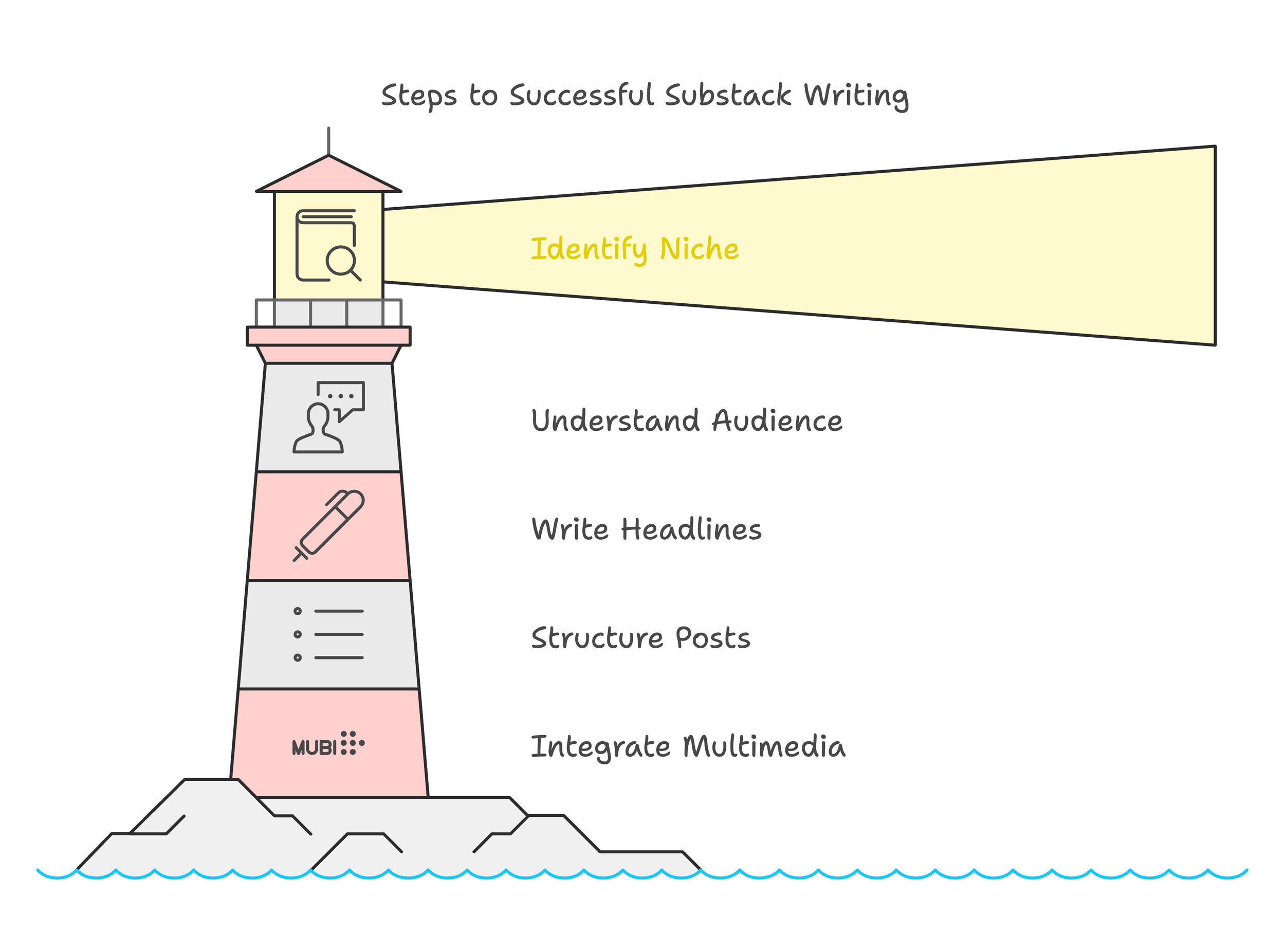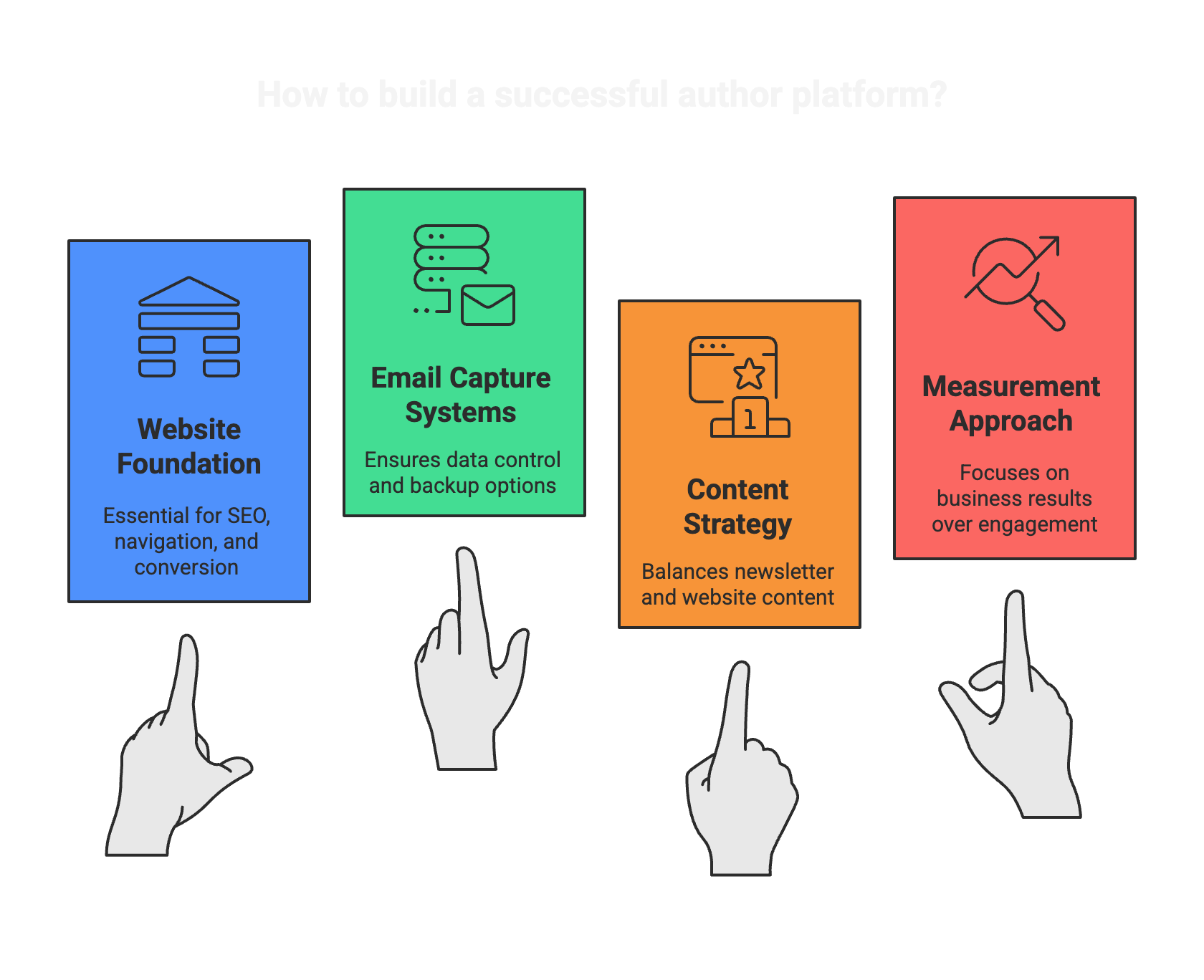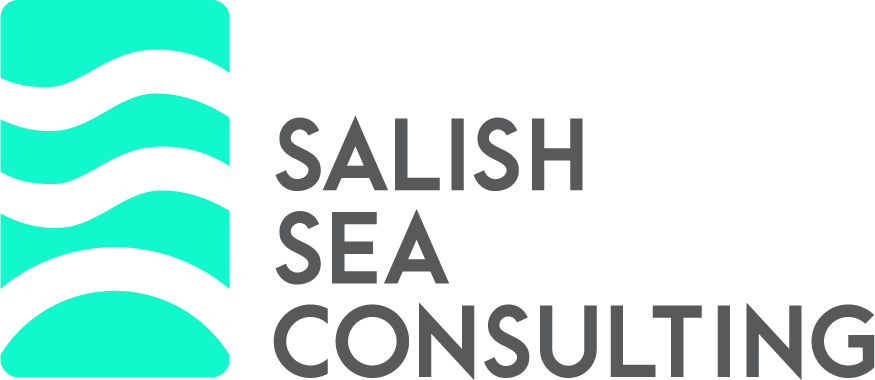Why Substack Writers Need Professional Websites Too

Most Substack Writers Make the Same Expensive Mistake
Michael Goodwin Hilton publishes his literary fiction on Substack. His newsletter "Little Things" has built a dedicated following through short stories, poetry, and personal essays. But here's what makes Hilton different from most Substack writers: he also maintains a professional author website that showcases his published collection "What The Statue Thinks."
Hilton didn't choose between platforms. He uses both strategically, and his book sales prove this approach works.
Winston Malone takes this strategy even further. His Substack "Storyletter XPress Publishing" builds community around his speculative fiction, but his professional website anchors his entire independent publishing business. Readers discover his subscription box service through his website, then engage with ongoing content through his newsletter.
Russell Nohelty demonstrates the same pattern with his Substack "The Author Stack." His newsletter provides free book marketing advice, but his website "The Author Life" converts that audience into course sales and coaching clients.
Three successful Substack writers. Three professional websites. Zero coincidence.
Why Most Substack Writers Struggle to Sell Books
Jane Friedman studied this problem extensively in her analysis of the platform. She found that paid newsletters typically convert only 1-5% of free readers. She calls getting readers to pay for newsletter content "master mode" difficulty.
But here's the problem most Substack writers miss: the platform optimizes for newsletter revenue, not book sales.
Think about your reader's buying journey. They discover your writing on Substack, enjoy your content, and decide they want to buy your book. Where do they go? They leave Substack, search for your book on Amazon, and complete their purchase on a completely different platform.
You just lost control of your customer relationship at the exact moment it matters most.
What Happens When You Google Successful Authors
Try this experiment right now. Search for any bestselling author's name plus the word "books." What shows up first?
Their professional website. Amazon listings. Goodreads pages. Bookstore links.
You won't find their Substack newsletter in those top results.
This creates a major discoverability problem for Substack writers. People who want to buy your books can't find them through the content you're creating on the platform. Your Substack posts don't rank in Google searches for "[Your Name] books" or "[Your Topic] books."
Professional opportunities present another challenge. Media interviews require polished author bio pages. Speaking engagements need comprehensive information about your expertise and previous work. Literary agents and publishers expect to find professional author websites when they research potential clients.
Conference organizers won't book speakers based solely on a Substack newsletter.

How Professional Author Website Design Solves These Problems
Author website design addresses every limitation that Substack writers face. A well-designed author website includes SEO-optimized pages that rank when people search for your name or your book topics. You control exactly how potential readers discover and learn about your work.
Book marketing websites excel at conversion in ways that Substack can't match. You can create dedicated landing pages for each book, integrate direct sales systems, and build email capture forms that grow your own list. When readers decide to purchase, they stay within your controlled environment instead of jumping to external platforms.
Professional author websites also open revenue streams that newsletter platforms can't provide. Speaking opportunities get booked through your website's media kit. Course sales happen through integrated e-commerce systems. Coaching inquiries come through professional contact forms.
The best part? Your website works perfectly with your Substack strategy. Your newsletter builds relationships while your website converts those relationships into book sales and professional opportunities.

Why Substack Writers Winston Malone and Russell Nohelty Chose Professional Websites
Malone's website establishes credibility for his publishing business in ways his newsletter couldn't. When potential partners or investors research his company, they need to see proof of professionalism and legitimacy. His Substack builds community, but his website handles business relationships.
The platforms work together strategically. Readers often discover Malone through Google searches for independent publishers. His website establishes credibility, then directs them to his Substack community where they engage with ongoing content and become paying supporters.
Nohelty follows the same pattern with his book marketing expertise. His website positions him as a professional consultant with clear service offerings and testimonials. His Substack demonstrates his knowledge through free advice, which naturally leads readers back to his website for paid services.
Both authors understand that professional author websites handle business interactions while newsletters handle community building. Neither platform could do both jobs effectively alone.
The Integration Strategy That Actually Works for Substack Writers
Smart Substack writers build what I call a dual-platform approach. They use their newsletter for what it does best: building engaged communities and sharing ongoing content. They use their professional website for what it does best: establishing credibility, ranking in search results, and converting readers into customers.
Your author website design should include several key elements that Substack can't provide. You need SEO-optimized author bio pages that rank for your name and expertise areas. Book pages should include direct purchase options, detailed descriptions, and reader testimonials. A speaking and media section opens doors to paid opportunities that newsletters alone won't generate.
Email capture systems on your website build lists that you own completely. This protects you from platform changes and gives you complete control over your audience relationships.
Your Substack strategy should support your website goals, not replace them. Use your newsletter to share behind-the-scenes content that drives traffic back to your website. Create book launch sequences that move subscribers from your newsletter to your book purchase pages. Build relationships through your newsletter, then monetize those relationships through your website.

Book Marketing Websites vs Newsletter Platforms: The Revenue Reality
Direct book sales through your website generate higher profit margins than Amazon-only sales. When readers purchase directly from you, you keep more money per sale and maintain the customer relationship for future book launches.
Professional websites enable multiple income streams that newsletter platforms can't support effectively. Speaking fees, workshop bookings, and consulting inquiries all flow through your website's professional infrastructure. Course creation and coaching services require e-commerce systems that integrate with your overall author platform.
The data ownership advantage can't be overstated. Your website analytics show you exactly how readers discover your books, which content converts best, and where you should focus your marketing efforts. Substack's analytics focus on newsletter metrics, not book sales metrics.
Building Both Platforms to Work Together
Start with your website foundation because everything else builds from there. Professional author website design requires book-focused SEO, clear navigation to your books, and conversion systems that turn visitors into buyers.
Your email capture systems should feed your own database, not just Substack's platform. This gives you backup options and complete control over your audience data.
Plan your content strategy to serve both platforms effectively. Your newsletter provides regular value to engaged subscribers. Your website serves as the professional hub where new readers learn about your expertise and discover your books.
The measurement approach should focus on business results, not just engagement metrics. Track book sales, speaking bookings, and website inquiries alongside your newsletter open rates. These business metrics matter more for your author career than newsletter statistics alone.

Professional Author Websites: Investment That Pays for Itself
Quality author website design costs less than most authors spend on ineffective book marketing campaigns. The difference is that your website works for you 24/7, ranking in search results and converting visitors while you sleep.
Consider the revenue potential. A single speaking engagement booked through your website often pays for your entire website investment. Course sales, coaching clients, and direct book sales add up quickly when you have professional systems in place.
The credibility factor alone justifies the investment for serious authors. Publishers, agents, media contacts, and speaking bureaus expect to find professional websites when they research potential partners.
Websites for Self-Published Authors: Complete Control Over Your Career
Self-published authors benefit even more from professional websites because they don't have publisher marketing support. Your website becomes your marketing department, sales team, and professional representative all in one.
You control your brand presentation completely. Your book descriptions, author bio, and professional credentials appear exactly as you want them. No platform algorithm decides how your work gets presented to potential readers.
The long-term asset value grows over time. Your website domain gains authority with search engines as you publish more content and attract more visitors. This compounds your marketing efforts year after year.
Ready to Build a Website That Works With Your Substack Strategy?
Most Substack writers will continue building audiences on rented land, hoping newsletter subscriptions eventually lead to book sales. Smart authors take control of their careers by combining newsletter community building with professional website infrastructure.
Your readers deserve a professional experience from the moment they discover you until they purchase your books and beyond. They want to find your work easily, learn about your expertise credibly, and buy from you directly.
The authors who thrive long-term use both platforms strategically. Their newsletters build relationships while their websites build businesses.
Which approach will you choose for your author career?
If you're ready to build a professional author website that works with your Substack strategy, let's design a platform that turns your newsletter subscribers into book buyers. Your writing deserves a website that matches your talent.




